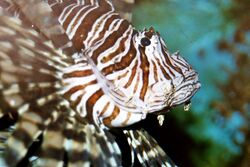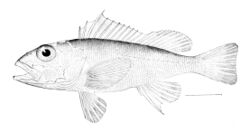Biology:Scorpaeniformes
| Scorpaeniformes | |
|---|---|

| |
| Scorpaenidae: Pterois antennata | |
| Scientific classification | |
| Domain: | Eukaryota |
| Kingdom: | Animalia |
| Phylum: | Chordata |
| Class: | Actinopterygii |
| Superorder: | Acanthopterygii |
| Order: | Scorpaeniformes Greenwood et al., 1966 |
| Type species | |
| Scorpaena porcus | |
| Suborders | |
|
see text | |
The Scorpaeniformes /skɔːrˈpiːnɪfɔːrmiːz/ are a diverse order of ray-finned fish, including the lionfishes and sculpins, but have also been called the Scleroparei. It is one of the five largest orders of bony fishes by number of species, with over 1,320.[1]
They are known as "mail-cheeked" fishes due to their distinguishing characteristic, the suborbital stay: a backwards extension of the third circumorbital bone (part of the lateral head/cheek skeleton, below the eye socket) across the cheek to the preoperculum, to which it is connected in most species.[2]
Scorpaeniform fishes are carnivorous, mostly feeding on crustaceans and on smaller fish. Most species live on the sea bottom in relatively shallow waters, although species are known from deep water, from the midwater, and even from fresh water. They typically have spiny heads, and rounded pectoral and caudal fins. Most species are less than 30 cm (12 in) in length, but the full size range of the order varies from the velvetfishes belonging to the family Aploactinidae, which can be just 2 cm (0.79 in) long as adults,[2] to the skilfish (Erilepis zonifer), which can reach 183 cm (6.00 ft) in total length.[3]
One of the suborders of the Scorpaeniformes is the Scorpaenoidei. This suborder is usually found in the benthic zone, which is the lowest region of any water body like oceans or lakes.
There are two groups of the Scorpaenoidei. The sea robins is the first, which are further classified into two families: the sea robins and the armored sea robins. One significant difference between the two families of sea robins is the presence of spine-bearing plate on the armored sea robins which is absent in the sea robins family.
The second group of the Scorpaenoidei suborder is the scorpionfishes, which according to Minouri Ishida's work in 1994 and recent studies, have twelve families. The scorpionfishes are very dynamic in size with the smallest one having a range of 2–3 cm, while the largest have a length of approximately 100 cm.[4]
Classification
The division of Scorpaeniformes into families is not settled; accounts range from 26[5] to 35 families.[6][7] The 5th edition of Fishes of the World classifies the order as follows:[8][9]


Order Scorpaeniformes
- Suborder Scorpaenoidei
- Superfamily Congiopodoidea
- Family Aploactinidae Jordan & Starks, 1904 (Velvetfishes)
- Family Congiopodidae Gill, 1889 (Racehorses, pigfishes or horsefishes)
- Superfamily Pataecoidea
- Family Pataecidae Gill, 1872 (Australian prowfishes)
- Family Gnathanacanthidae Gill, 1892 (Red velvetfish)
- Superfamily Scorpaenoidea
- Family Eschmeyeridae Mandrytsa, 2001 (the cofish)
- Family Scorpaenidae Risso, 1827 (Scorpionfishes)
- Superfamily Congiopodoidea
- Suborder Platycephaloidei
- Superfamily Platycephaloidea
- Family Bembridae Kaup, 1873 (Deepwater flatheads)
- Family Platycephalidae Swainson, 1839 (True flatheads)
- Family Hoplichthyidae Kaup, 1873 (Ghost flatheads)
- Superfamily Trigloidea
- Family Triglidae Rafinesque, 1815 (Common searobins)
- Family Peristediidae Jordan & Gilbert, 1883 (Armored searobins)
- Superfamily Platycephaloidea
- Suborder Normanichthyiodei
- Family Normanichthyidae Clark, 1837 (the Barehead scorpionfish or mote sculpin)
- Suborder Zoarcoidei
- Superfamily Anarhichadoidea
- Family Anarhichadidae Bonaparte, 1835 (Wolffishes)
- Family Cryptacanthodidae Gill, 1861 (Wrymouths)
- Family Stichaeidae Gill, 1864 (Pricklebacks)
- Family Pholidae Gill, 1893 (Gunnels)
- Superfamily Bathymasteroidea
- Family Bathymasteridae Jordan & Gilbert, 1883 (Ronquils)
- Family Ptilichthyidae Jordan & Gilbert, 1883 (Quillfish)
- Superfamily Zoarcoidea
- Family Eulophiidae H. M. Smith, 1902 (Spinous eelpouts)[10]
- Family Zoarcidae Swainson, 1839 (True Eelpouts)
- Superfamily Zaproroidea
- Family Scytalinidae Jordan & Starks, 1895 (Graveldivers)
- Family Zaproridae Jordan, 1896 (Prowfishes)
- Superfamily Anarhichadoidea
- Suborder Gasterosteoidei
- Family Hypoptychidae Steindachner, 1880 (the Korean Sandlance)
- Family Aulorhynchidae Gill (1861) (Tubesnouts)
- Family Gasterosteidae Bonaparte, 1831 (Sticklebacks)
- Suborder Cottoidei
- Superfamily Anoplopomatoidea (Quast, 1965)[11]
- Family Anoplopomatidae Jordan & Gilbert, 1883 (Blackcod)
- Superfamily Zaniolepidoidea Shinohara, 1994[12]
- Family Zaniolepididae Jordan & Gilbert, 1883 (Combfishes)
- Superfamily Hexagrammoidea Gill, 1889
- Family Hexagrammidae Jordan, 1888 (Greenlings)
- Superfamily Trichodontoidea Nazarkin & Voskoboinikova, 2000[13]
- Family Trichodontidae Bleeker, 1859 (Sandfishes)
- Superfamily Cottoidea Gill, 1889[14]
- Family Jordaniidae Jordan & Evermann, 1898 (Longfin sculpins)
- Family Rhamphocottidae Jordan & Gilbert, 1883 (Grunt sculpins)
- Family Scorpaenichthyidae Jordan & Evermann, 1898
- Family Agonidae Swainson, 1839 (Poachers and searavens)
- Family Cottidae Bonaparte, 1831 (Sculpins)
- Family Psychrolutidae Günther, 1861 (Bighead sculpins)
- Family Bathylutichthyidae Balushkin & Voskoboinikova, 1990 (Antarctic sculpins)
- Superfamily Cyclopteroidea Gill, 1873[15]
- Family Cyclopteridae Bonaparte, 1831 (lumpfishes or lumpsuckers)
- Family Liparidae Gill, 1861 (Snailfishes)
- Superfamily Anoplopomatoidea (Quast, 1965)[11]
This classification is not settled, however, and some authorities classify these groupings largely within the Order Perciformes as the suborders Scorpaenoidei, Platycephaloidei, Triglioidei and Cottoidei, Cottodei including the infraorders Anoplopomatales, Zoarcales, Gasterosteales, Zaniolepidoales, Hexagrammales and Cottales. These infraorders largely correspond with the superfamilies in the Cottoidei set out in the 5th edition of Fishes of the World.[16]
Timeline of genera
<timeline> ImageSize = width:1000px height:auto barincrement:15px PlotArea = left:10px bottom:50px top:10px right:10px
Period = from:-66.0 till:10 TimeAxis = orientation:horizontal ScaleMajor = unit:year increment:5 start:-65 ScaleMinor = unit:year increment:1 start:-65 TimeAxis = orientation:hor AlignBars = justify
Colors =
#legends id:CAR value:claret id:ANK value:rgb(0.4,0.3,0.196) id:HER value:teal id:HAD value:green id:OMN value:blue id:black value:black id:white value:white id:cenozoic value:rgb(0.54,0.54,0.258) id:paleogene value:rgb(0.99,0.6,0.32) id:paleocene value:rgb(0.99,0.65,0.37) id:eocene value:rgb(0.99,0.71,0.42) id:oligocene value:rgb(0.99,0.75,0.48) id:neogene value:rgb(0.999999,0.9,0.1) id:miocene value:rgb(0.999999,0.999999,0) id:pliocene value:rgb(0.97,0.98,0.68) id:quaternary value:rgb(0.98,0.98,0.5) id:pleistocene value:rgb(0.999999,0.95,0.68) id:holocene value:rgb(0.999,0.95,0.88)
BarData=
bar:eratop bar:space bar:periodtop bar:space bar:NAM1 bar:NAM2 bar:NAM3 bar:NAM4 bar:NAM5 bar:NAM6 bar:NAM7 bar:NAM8 bar:NAM9 bar:NAM10 bar:NAM11 bar:NAM12 bar:NAM13 bar:NAM14 bar:NAM15 bar:NAM16 bar:NAM17 bar:NAM18 bar:NAM19 bar:NAM20 bar:NAM21 bar:NAM22 bar:NAM23 bar:NAM24 bar:NAM25 bar:NAM26 bar:NAM27 bar:NAM28 bar:NAM29 bar:NAM30 bar:NAM31 bar:NAM32 bar:space bar:period bar:space bar:era
PlotData=
align:center textcolor:black fontsize:M mark:(line,black) width:25 shift:(7,-4)
bar:periodtop from: -66.0 till: -55.8 color:paleocene text:Paleocene from: -55.8 till: -33.9 color:eocene text:Eocene from: -33.9 till: -23.03 color:oligocene text:Oligocene from: -23.03 till: -5.332 color:miocene text:Miocene from: -5.332 till: -2.588 color:pliocene text:Plio. from: -2.588 till: -0.0117 color:pleistocene text:Pleist. from: -0.0117 till: 0 color:holocene text:H.
bar:eratop from: -66.0 till: -23.03 color:paleogene text:Paleogene from: -23.03 till: -2.588 color:neogene text:Neogene from: -2.588 till: 0 color:quaternary text:Q.
PlotData=
align:left fontsize:M mark:(line,white) width:5 anchor:till align:left
color:eocene bar:NAM1 from:-55.8 till:-48.6 text:Eosynanceja color:eocene bar:NAM2 from:-55.8 till:-33.9 text:Eocottus color:eocene bar:NAM3 from:-55.8 till:-5.33 text:Ctenopomichthys color:eocene bar:NAM4 from:-55.8 till:0 text:Platycephalus color:eocene bar:NAM5 from:-37.2 till:0 text:Lepidotrigla color:eocene bar:NAM6 from:-37.2 till:0 text:Notesthes color:eocene bar:NAM7 from:-37.2 till:0 text:Podothecus color:eocene bar:NAM8 from:-37.2 till:0 text:Scorpaena color:oligocene bar:NAM9 from:-33.9 till:0 text:Agonus color:oligocene bar:NAM10 from:-33.9 till:0 text:Pontinus color:oligocene bar:NAM11 from:-33.9 till:0 text:Sebastes color:oligocene bar:NAM12 from:-33.9 till:0 text:Trigla color:miocene bar:NAM13 from:-23.03 till:0 text:Neoplatycephalus color:miocene bar:NAM14 from:-23.03 till:0 text:Peristedion color:miocene bar:NAM15 from:-15.97 till:0 text:Hoplichthys color:miocene bar:NAM16 from:-11.61 till:-5.33 text:Achrestogrammus color:miocene bar:NAM17 from:-11.61 till:-5.33 text:Lirosceles color:miocene bar:NAM18 from:-11.61 till:0 text:Sebastodes color:pliocene bar:NAM19 from:-5.33 till:0 text:Artedius color:pliocene bar:NAM20 from:-5.33 till:0 text:Chitonotus color:pliocene bar:NAM21 from:-5.33 till:0 text:Enophrys color:pliocene bar:NAM22 from:-5.33 till:0 text:Icelinus color:pliocene bar:NAM23 from:-5.33 till:0 text:Lepidocottus color:pliocene bar:NAM24 from:-5.33 till:0 text:Leptocottus color:pliocene bar:NAM25 from:-5.33 till:0 text:Malacocottus color:pliocene bar:NAM26 from:-5.33 till:0 text:Prionotus color:pliocene bar:NAM27 from:-5.33 till:0 text:Radulinus color:pleistocene bar:NAM28 from:-2.59 till:0 text:Cyclopterus color:pleistocene bar:NAM29 from:-2.59 till:0 text:Eutrigla color:pleistocene bar:NAM30 from:-2.59 till:0 text:Ophiodon color:pleistocene bar:NAM31 from:-2.59 till:0 text:Scorpaenichthys color:pleistocene bar:NAM32 from:-2.59 till:0 text:Zaniolepis
PlotData=
align:center textcolor:black fontsize:M mark:(line,black) width:25
bar:period from: -66.0 till: -55.8 color:paleocene text:Paleocene from: -55.8 till: -33.9 color:eocene text:Eocene from: -33.9 till: -23.03 color:oligocene text:Oligocene from: -23.03 till: -5.332 color:miocene text:Miocene from: -5.332 till: -2.588 color:pliocene text:Plio. from: -2.588 till: -0.0117 color:pleistocene text:Pleist. from: -0.0117 till: 0 color:holocene text:H.
bar:era from: -66.0 till: -23.03 color:paleogene text:Paleogene from: -23.03 till: -2.588 color:neogene text:Neogene from: -2.588 till: 0 color:quaternary text:Q.
</timeline>
See also
Notes
References
- ↑ "Umich.edu". http://www.biokids.umich.edu/critters/Scorpaeniformes.
- ↑ 2.0 2.1 Eschmeyer, William N. (1998). Paxton, J.R.. ed. Encyclopedia of Fishes. San Diego: Academic Press. p. 175. ISBN 0-12-547665-5.
- ↑ Froese, Rainer and Pauly, Daniel, eds. (2021). "Erilepis zonifer" in FishBase. June 2021 version.
- ↑ "Scorpaeniformes II (Scorpionfishes and Relatives) | Encyclopedia.com". https://www.encyclopedia.com/environment/encyclopedias-almanacs-transcripts-and-maps/scorpaeniformes-ii-scorpionfishes-and-relatives.
- ↑ "Scorpaeniformes". Integrated Taxonomic Information System. https://www.itis.gov/servlet/SingleRpt/SingleRpt?search_topic=TSN&search_value=166702.
- ↑ William N. Eschmeyer; Carl J. Ferraris; Mysi D. Hoang; Douglas J. Long (1998). Catalog of Fishes. California Academy of Sciences. ISBN 0-940228-47-5.
- ↑ Froese, Rainer, and Daniel Pauly, eds. (2006). "Scorpaeniformes" in FishBase. February 2006 version.
- ↑ J. S. Nelson; T. C. Grande; M. V. H. Wilson (2016). Fishes of the World (5th ed.). Wiley. pp. 467–495. ISBN 978-1-118-34233-6. https://sites.google.com/site/fotw5th/. Retrieved 27 October 2021.
- ↑ Richard van der Laan; William N. Eschmeyer; Ronald Fricke (2014). "Family-group names of Recent fishes". Zootaxa 3882 (2): 001–230. doi:10.11646/zootaxa.3882.1.1. PMID 25543675. https://www.researchgate.net/publication/268078514.
- ↑ Hyuck Joon Kwun; Jin-Koo Kim (2003). "Molecular phylogeny and new classification of the genera Eulophias and Zoarchias (PISCES, Zoarcoidei)". Molecular Phylogenetics and Evolution 69 (3): 787–795. doi:10.1016/j.ympev.2013.06.025. PMID 23845463.
- ↑ Catherine W. Mecklenburg (2003). "Family Anoplopomatidae Jordan & Gilbert 1883 sablefishes". California Academy of Sciences Annotated Checklists of Fishes 2. https://www.calacademy.org/sites/default/files/assets/docs/anoplopomatidae.pdf.
- ↑ Catherine W. Mecklenburg; William N. Eschmeyer (2003). "Family Hexagrammidae Gill 1889 Greenlings". California Academy of Sciences Annotated Checklists of Fishes 2. https://www.calacademy.org/sites/default/files/assets/docs/hexagrammidae.pdf.
- ↑ Catherine W. Mecklenburg (2003). "Family Trichodontidae Bleeker 1859 — sand fishes". California Academy of Sciences Annotated Checklists of Fishes 15. https://www.calacademy.org/sites/default/files/assets/docs/trichodontidae.pdf.
- ↑ Mamoru Yabe (1985). "Comaprative Osteology and Myology of the Superfamily Cottoidea OPisces:Scorpaeniformes), and its Phylogenetic Classification". Memoirs off the Faculty of Fishes Hokkaido University 32 (1): 1–130.
- ↑ Catherine W. Mecklenburg; Boris A. Sheiko (2003). Family Cyclopteridae Bonaparte 1831 - lumpsuckers. 6. https://www.calacademy.org/sites/default/files/assets/docs/cyclopteridae.pdf.
- ↑ Ricardo Betancur-R; Edward O. Wiley; Gloria Arratia et al. (2017). "Phylogenetic classification of bony fishes". BMC Evolutionary Biology 17 (162): 162. doi:10.1186/s12862-017-0958-3. PMID 28683774.
- Sepkoski, Jack (2002). "A compendium of fossil marine animal genera". Bulletins of American Paleontology 364: 560. http://strata.ummp.lsa.umich.edu/jack/showgenera.php?taxon=611&rank=class. Retrieved 2011-05-17.
Wikidata ☰ Q208777 entry
 |


